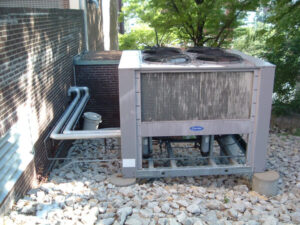Mechanical Noise Control Tips
Mechanical noise control helps keep a facility’s HVAC systems and equipment from creating acoustically undesirable environments. While each project offers unique sound-related challenges, we’re happy to provide some tips that apply to many spaces.

Locate mechanical equipment on grade, if possible.
Mechanical Rooms and Equipment
To achieve proper ambient noise levels, locate mechanical equipment rooms as far as possible from noise-sensitive spaces. The mechanical rooms should not share common walls, floors, ceilings with these areas.
Then, construct the walls, ceilings, and floors surrounding the mechanical rooms with sufficient mass to properly isolate the mechanical noise from the adjacent spaces. This could consist of multiple-layer constructions, or constructions with acoustical products, such as isolation clips. Also, consider treating the walls and ceilings with sound-absorbing material. This can reduce the build-up of airborne noise within the mechanical spaces.
Air-Distribution Systems

The not-so-pretty side of architecture projects.
Selecting a low-velocity, low-pressure air-distribution system will not only help control airflow noise; it will also conserve energy! Also, consider using air handling units with airfoil or backward-inclined centrifugal fan wheels. Forward-curved centrifugal fans or vane axial fans typically produce more noise.
In addition, providing duct silencers and/or duct lining in supply and return air ducts will reduce the overall noise levels. If possible, locate these silencers in the penetration of the mechanical room wall, ceiling, or floor, depending on the duct layout.
Systems with variable air volume or fan-powered boxes will typically require further analysis to determine he appropriate application of duct silencers and lining. However, in general, locating these units in corridors can help keep radiated noise from intruding into noise sensitive spaces, such as classrooms.
Vibration Isolation
For better structural support, place vibrating equipment near columns or above load-bearing walls. To provide better sound isolation and structural support, consider using vibration isolators as part of the equipment mounting. Vibration isolators can range from simple neoprene pads to integrated support frames with springs, or even air spring mounts in some critical situations. In general, mount fans on structural steel frames or rail bases, and pumps on concrete inertia bases. For chillers, mount on rail bases or with spring assemblies attached directly to the chiller frame. Suspend the heat pump or fan coil units from above with spring hangers.
Every space has unique mechanical noise control requirements and challenges. An acoustical consultant can recommend the most appropriate options for your facility and equipment. Contact our experts to talk about your project.


